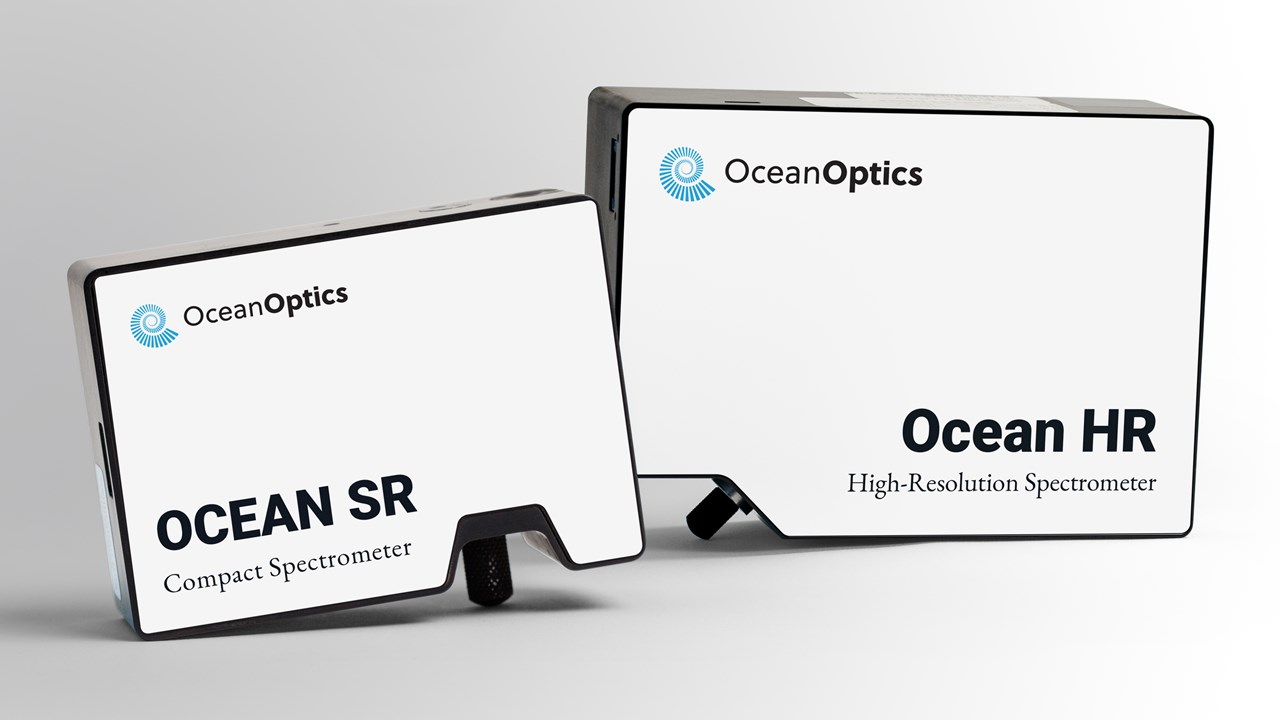How does the internal shutter of the QE Pro spectrometer operate? Is it possible to add the shutter to earlier-model Ocean Optics spectrometers?
The QE Pro internal shutter is controlled in OceanView spectroscopy software by activating GPIO #4 in the spectrometer. The shutter is available on newer-model, large-bench spectrometers (QE Pro and NIRQuest) and is installed at the time of spectrometer assembly. You can add the shutter later, but that incurs additional costs and time for rework.
What is the thermal wavelength stability of Ocean Optics spectrometers?
Stability is a broad term that encompasses various elements of the spectrometer system, including the optical bench, electronics and light source. Typically, users are interested in thermal wavelength stability, which is a measure of the change in specifications (performance) at various temperatures. Stability is often expressed in pixels per °C for a passive device or as +/- °C per setpoint temperature with an active device.
We offer three primary options for maintaining thermal stability in spectrometers:
- In this scenario, the spectrometer’s design promotes stability. The Flame, Ocean HDX and other newer model spectrometers were developed with thermal stability in mind.
- Temperature Controller. These are active devices for controlling temperature. Options include thermoelectric coolers, like those installed on QE Pro and NIRQuest spectrometers; and external devices like the USB-TC, which attaches to Flame and USB series spectrometers.
- Procedural Approach. You can use experiment controls to mitigate the effects of temperature variation. Examples include taking frequent reference and dark measurements, integrating reference monitoring into the procedure, and using electrical dark correction.
Legacy USB2000 Not Recognized on Windows 8.x/10
WARNING: Do not flash USB2000+ spectrometers with legacy USB2000 firmware, or permanent corruption of its FX/2 chip will occur.
Certain versions of the USB2000 (a legacy precursor to later-model spectrometers) can have problems showing up in OceanView on Windows 8.x or 10 computers. This can be resolved by upgrading the USB2000 FX2 firmware to version 2.51.0.
The firmware may need to be updated to the EEPROM in your USB2000 spectrometer. After this has been done, it will work properly on Windows 8.x and Windows 10 using OceanView software.
Please note that the firmware update has a small possibility of corrupting the EEPROM. If this happens, the spectrometer may need to be sent in for repair. This must be done in Windows. It is best to do this with no other programs running. Note: This programming process cannot be done on a computer with Windows 8.x or 10; please use a different computer with Windows 7, Vista, or XP.
Follow These Steps
- Install USB Programmer. Go to our software downloads page and look for the “Microcode” section under Miscellaneous Tools and Utilities. Select the version that corresponds to your operating system (32- or 64-bit Windows). Note: If using 32-bit Windows operating system and the EZUSB driver for reprogramming, please download and install the EZUSB version of 32-bit Windows USB Programmer.
- Save the firmware file on any location of your computer.
- Attach your spectrometer to the USB port on your computer.
- Run the USB Programmer by selecting Start | Programs | Ocean Optics | USB Programmer |USB programmer. This utility will display your spectrometer in the left-hand pane. It may be seen under “USB2000 Devices.”
- Click on the spectrometer line below “USB2000 Devices.” It will contain the spectrometer’s serial number.
- Once you select the device, additional information will be displayed on the right side of the window. The spectrometer’s current FX/2 firmware version will be displayed at top right.
- Click the “Program FX/2” button located on the Main Menu.
- Locate the firmware file, click on it and click Open.
Note: Do not interrupt the programming process for any reason! If the programming process is interrupted, permanent corruption can occur on the USB device. Programming will take a few minutes. IMPORTANT INFORMATION: Even if all steps are followed correctly, there is a small possibility that the spectrometer will not function after the firmware is updated and additional assistance will be required.
- When programming is complete unplug the USB device from the PC, and then plug the device back into the PC to allow the new program to take effect.
- Wait about 10 seconds for its driver to load, and then click the “Refresh Tree” button.
- Click on the spectrometer’s serial number (it should be under “USB2000 Devices”) to see the updated firmware version. Note: This firmware version displays as blank.
If the Driver is Still Not Found
If the driver is still not found after you’ve installed the USB Programmer and plugged in your USB2000, please try the following:
You should see the message “Your hardware was installed successfully” when finished.
Go to Device Manager and find the “Ocean Optics USB2000” (it should be under the category “Other Devices”).
Right-click on the “Ocean Optics USB2000” and select “Update Driver Software.” You will get a choice of finding the driver automatically or “Browse My Computer.”
Select Browse and then browse to the following directory: “C:\Program Files\Ocean Optics\USBProgrammerWinUSB-4.2\distribution.” Please be sure to select the “distribution” directory, and not the subfolder.
After you select the “distribution” directory, click “OK” and then “Next.” You may get a message that “Windows cannot verify the publisher,” but click on “Install Anyway” and the device driver installation will begin.
Legacy HR2000 Not Recognized on Windows 8.x/10
WARNING: Do not flash HR2000+ spectrometers with legacy HR2000 firmware, or permanent corruption of the FX/2 chip will occur.
Certain versions of the HR2000 (legacy precursor to the higher-performance HR2000+) can have problems showing up in OceanView on Windows 8.x or 10 computers. This can be resolved by upgrading the HR2000 FX2 firmware to version 102.0.
The firmware may need to be updated to the EEPROM in your HR2000 spectrometer. After this has been done, the spectrometer will work properly on Windows 8.x and Windows 10 using OceanView software.
Please note that the firmware update has a small possibility of corrupting the EEPROM. If this happens, the spectrometer may need to be sent in for repair.
Firmware updates must be done in Windows. It is best to do this with no other programs running. Note: This programming process cannot be done on a computer with Windows 8.x or 10; please use a different computer with Windows 7, Vista, or XP.
Follow These Steps
- Install USB Programmer. Go to our software downloads page and look for the “Microcode” section under Miscellaneous Tools and Utilities. Select the version that corresponds to your operating system (32- or 64-bit Windows). Note: If you’re using a 32-bit Windows operating system and the EZUSB driver for reprogramming, please download and install the EZUSB version of 32-bit Windows USB Programmer.
- Save the firmware file on any location of your computer.
- Attach your spectrometer to the USB port on your computer.
- Run the USB Programmer by selecting Start | Programs | Ocean Optics | USB Programmer |USB programmer. This utility will display your spectrometer in the left-hand pane. It may be seen under “HR2000 Devices.”
- Click on the spectrometer line below “HR2000 Devices.” It will contain the spectrometer’s serial number.
- Once you select the device, additional information will be displayed on the right side of the window. The spectrometer’s current FX/2 firmware version will be displayed at the top on the right.
- Click the “Program FX/2” button, located on the Main Menu.
- Locate the firmware file, click on it and click Open.
Note: Do not interrupt the programming process for any reason! If the programming process is interrupted, permanent corruption can occur on the USB device. Programming will take a few minutes. IMPORTANT INFORMATION: Even if all is done correctly, there is a small possibility that the spectrometer will not function after the firmware is updated.
- When programming is complete unplug the USB device from the PC, and then plug the device back into the PC to allow the new program to take effect.
- Wait about 10 seconds for its driver to load, and then click the “Refresh Tree” button.
- Click on the spectrometer’s serial number (it should be under “HR2000 Devices”) to see the updated firmware version. Note: This firmware version displays as blank.
If the Driver is Still Not Found
If the driver is still not found after you’ve installed the USB Programmer and plugged in your HR2000, please try the following:
- Go to Device Manager and find the “Ocean Optics HR2000” (it should be under the category “Other Devices”).
- Right-click on the “Ocean Optics HR2000” and select “Update Driver Software.” You will get a choice of finding the driver automatically or “Browse My Computer.”
- Select Browse and then browse to the following directory: “C:\Program Files\Ocean Optics\USBProgrammerWinUSB-4.2\distribution.” Please be sure to select the “distribution” directory, and not the sub-folder.
- After you select the “distribution” directory, click “OK” and then “Next.” You may get a message that “Windows cannot verify the publisher” but click on “Install Anyway” and the device driver installation will begin.
- It should display “Your hardware was installed successfully” when finished.
We Are Here to Help
Regulatory
Standards, Terms & Conditions, and More.

Contact Us
Product Info, Tech Support, Returns and More.

